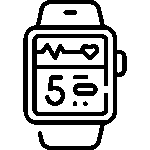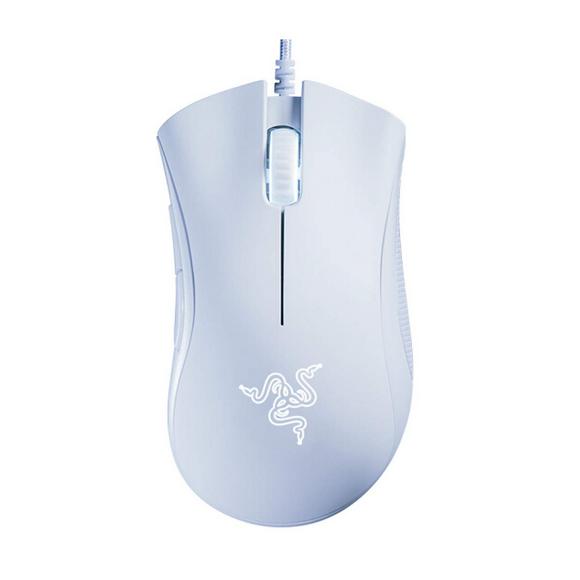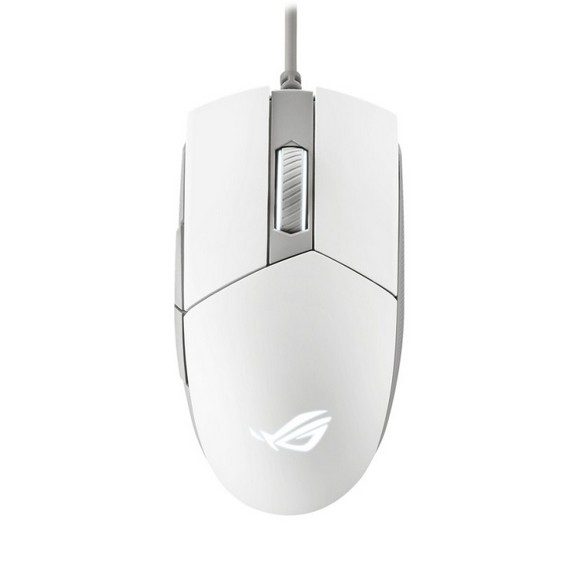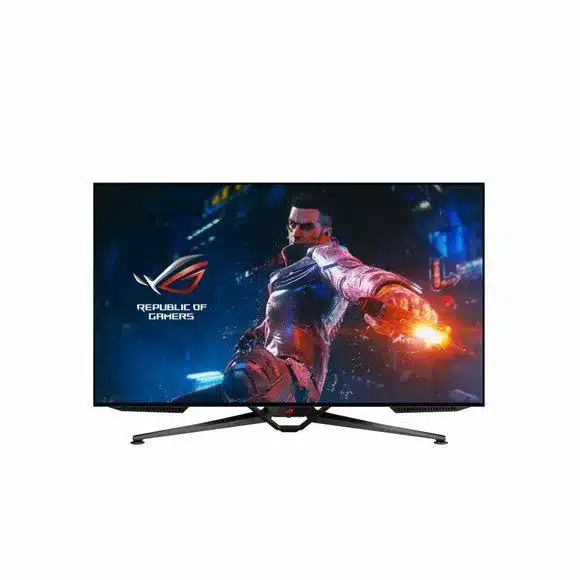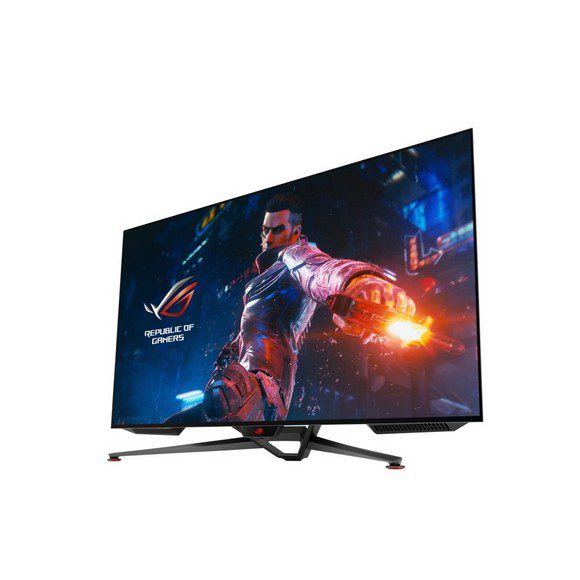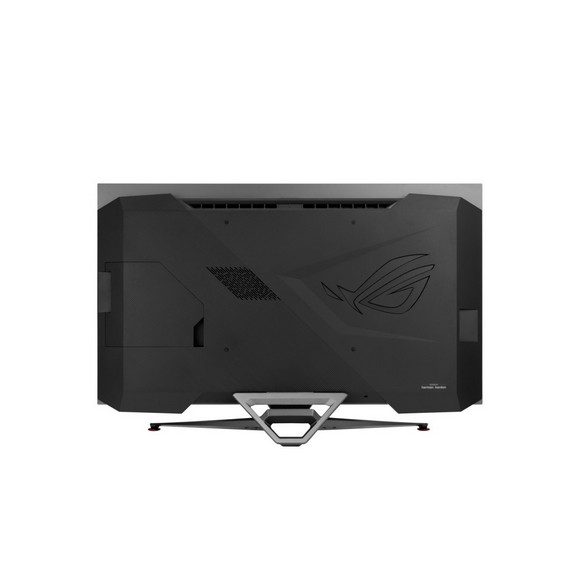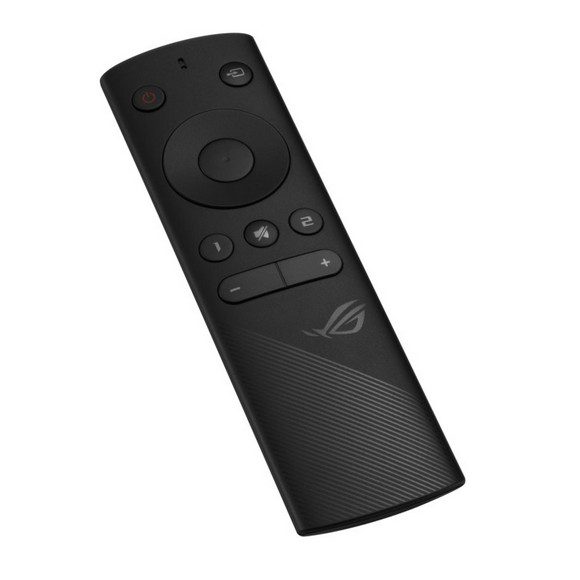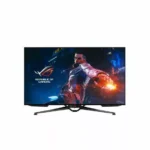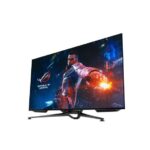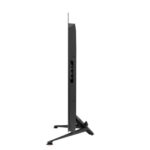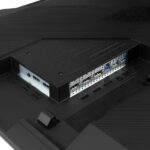Asus ROG Swift PG42UQ 4K, OLED, 138Hz (overclocked), 0.1 ms (GTG), G-SYNC® Compatible Gaming Monitors Price in Pakistan
| Brand
Name of the company-manufacturer. |
Asus |
| Model
Designation of the model. |
ROG Swift PG42UQ |
| Model alias
Other known designations of the model. |
ROG Swift OLED PG42UQ |
| Model year
The year in which this model was announced. |
2022 |
Display
Information about the main characteristics of the display – panel, backlight, resolution, refresh rate, etc.
| Size class
Size class of the display as declared by the manufacturer. Often this is the rounded value of the actual size of the diagonal in inches. |
41.54 in (inches) |
| Diagonal
Approximate diagonal size of the display. If the manufacturer does not provide such information, the diagonal is calculated from the width and height of the screen. |
1055.2 mm (millimeters) 105.52 cm (centimeters) 41.5433 in (inches) 3.4619 ft (feet) |
| Width
Approximate width of the display. If the manufacturer does not provide such information, the width is calculated from the diagonal and the aspect ratio. |
919.68 mm (millimeters) 91.968 cm (centimeters) 36.2079 in (inches) 3.0173 ft (feet) |
| Height
Approximate height of the display. If the manufacturer does not provide such information, the height is calculated from the diagonal and the aspect ratio. |
517.32 mm (millimeters) 51.732 cm (centimeters) 20.3669 in (inches) 1.6972 ft (feet) |
| Panel type
There are various panel technologies. Each has its own specific features – viewing angles, color reproduction, response time, brightness/contrast, production cost, etc. The image quality depends directly on the type of the display panel used. |
OLED |
| Panel bit depth
The most widely used panels are those with 6, 8, and 10 bits for each of the RGB components of the pixel. They provide 18-, 24-, and 30-bit color, respectively. |
10 bits |
| FRC
Frame Rate Control (FRC) is a method, which allows the pixels to show more color tones. With quick cyclic switching between different color tones, an illusion for a new intermediate color tone is created. For example, by using FRC, a 6-bit display panel is able to show 16.7 millioin colors, which are typical for 8-bit display panels, and not the standard 262200 colors, instead. There are different FRC algorithms. |
No |
| Colors
The maximum number of colors, which the display is able to reproduce, depends on the type of the panel in use and color enhancing technologies like FRC. |
1073741824 colors 30 bits |
| Aspect ratio
The ratio between the horizontal and the vertical side of the display. Some of the standard and widely used aspect ratios are 4:3, 5:4, 16:9 and 16:10. |
1.778:1 16:9 |
| Resolution
Information about the number of pixels on the horizontal and vertical side of the screen. A higher resolution allows the display of a more detailed and of higher quality image. |
3840 x 2160 pixels Ultra HD (UHD) / 4K / 2160p |
| Pixel pitch
The pixel pitch shows the distance from the centers of two neighboring pixels. In displays, which have a native resolution (the TFT ones, for example), the pixel pitch depends on the resolution and the size of the screen. |
0.24 mm (millimeters) 0.024 cm (centimeters) 0.0094 in (inches) 0.0008 ft (feet) |
| Pixel density
Information of the number of pixels in a unit of length. With the decrease of the display size and the increase of its resolution, the pixel density increases. |
106 ppi (pixels per inch) 41 ppcm (pixels per centimeter) |
| Display area
The percentage of the approximate area, taken by the active part of the screen, to the total front area. |
91.89 % (percent) |
| sRGB
sRGB is a color space, developed jointly by Hewlett-Packard and Microsoft in 1996. It is used in different devices such as printers, displays, TV sets, cameras, etc. The sRGB color space covers about 72% of the NTSC color space. |
133 % (percent) |
| DCI P3
DCI P3 is a color space, introduced in 2007 by the SMPTE. It is used in digital cinema and has a much wider gamut than the sRGB. |
98 % (percent) |
| Brightness
Information about the brightness of the screen. It is measured in candela per square metre (cd/m²). |
400 cd/m² (candela per square meter) |
| Peak brightness
Often even a higher peak luminance can be achieved under certain conditions. For example, when a smaller area/APL of the display is used for showing a bright object, when a bright object is displayed for a short time, etc. |
900 cd/m² (candela per square meter) |
| Static contrast
The static contrast shows the ratio between the brightest and the darkest color, which the display can reproduce simultaneously, for example, within one and the same frame/scene. |
135000 : 1 |
| Dynamic contrast
The dynamic contrast shows the ratio between the brightest and the darkest color, which the display can reproduce over time, for example, in the course of playing a video. |
1500000 : 1 |
| HDR
HDR expands the contrast ratio (peak luminance and minimal black levels) and color palette to achieve more details across the whole image – from the darkest parts to the brightest ones, which results in more realistic and life-like image. |
HDR10 |
| Minimum response time
Information about the minimum amount of time, in which the pixels change from one color to another. Very often the manufacturer provides the response time for transition from grey-to-grey (G2G). |
0.1 ms (milliseconds) 0.0001 s (seconds) |
| Maximum response time
Information about the maximum amount of time, in which the pixels change from one color to another. |
2.8 ms (milliseconds) 0.0028 s (seconds) |
| Input lag
Desktop monitors and smart TVs experience a latency/lag in visualizing the information. The time in milliseconds that the display needs to visualize the signal input. |
4.2 ms (milliseconds) 0.0042 s (seconds) |
| Coating
Information about the type of coating of the display. There are different types of matte and glossy coatings, each of which has its own advantages and drawbacks. |
Anti-glare/Matte |
| Micro-texture coating |
Frequencies
Information about the horizontal and vertical refresh rates/frequencies.
| Horizontal frequency (digital)
The horizontal scan rate/frequency shows the number of horizontal lines, displayed by the monitor per second, when it is plugged to a digital source. |
30 kHz – 311 kHz (kilohertz) |
| Vertical frequency (digital)
The vertical frequency/refresh rate shows how many times in a second the image on the screen is refreshed. |
48 Hz – 138 Hz (hertz) |
| DisplayPort – 30 kHz – 311 kHz; 48 Hz – 138 Hz HDMI 2.1 – 30 kHz – 311 kHz; 48 Hz – 138 Hz HDMI 2.0 – 30 kHz – 135 kHz; 48 Hz – 60 Hz |
Power supply and consumption
Information about the power supply and consumption, energy efficiency class, etc.
| 110V
Permissible voltage tolerance in a 110-volt electric system. |
100 V – 120 V (volts) |
| 220V
Permissible voltage tolerance in a 220-volt electric system. |
220 V – 240 V (volts) |
| Alternating current frequency
Requirement regarding the alternating current frequency in the electric system. |
50 Hz – 60 Hz (hertz) |
| Electric current (A)
Requirement regarding the electric current rating in amperes (A) of the electric system. |
4 A (amperes) |
| Power consumption (off)
Power consumption in off-mode. |
0.3 W (watts) |
| Power consumption (sleep)
Power consumption in sleep/stand by/suspend mode. |
0.3 W (watts) |
| Power consumption (average)
Average power consumption in standard work mode. |
300 W (watts) |
Dimensions, weight and color
Information about the dimensions and the weight of the specific model with and without stand as well as the colors, in which it is offered to the market.
| Width
Width without stand in different measurement units. |
938.08 mm (millimeters) 93.808 cm (centimeters) 36.9323 in (inches) 3.0777 ft (feet) |
| Height
Height without stand in different measurement units. |
551.96 mm (millimeters) 55.196 cm (centimeters) 21.7307 in (inches) 1.8109 ft (feet) |
| Depth
Depth without stand in different measurement units. |
37.38 mm (millimeters) 3.738 cm (centimeters) 1.4717 in (inches) 0.1226 ft (feet) |
| Weight
Weight without stand in different measurement units. |
13.6 kg (kilograms) 29.98 lbs (pounds) |
| Width with stand
Width with stand in different measurement units. |
938.08 mm (millimeters) 93.808 cm (centimeters) 36.9323 in (inches) 3.0777 ft (feet) |
| Height with stand
Height with stand in different measurement units. |
611.3 mm (millimeters) 61.13 cm (centimeters) 24.0669 in (inches) 2.0056 ft (feet) |
| Depth with stand
Depth with stand in different measurement units. |
255.4 mm (millimeters) 25.54 cm (centimeters) 10.0551 in (inches) 0.8379 ft (feet) |
| Weight with stand
Weight with stand in different measurement units. |
14.77 kg (kilograms) 32.56 lbs (pounds) |
| Box width
Width of the package in different measurement units. |
1070 mm (millimeters) 107 cm (centimeters) 42.126 in (inches) 3.5105 ft (feet) |
| Box height
Height of the package in different measurement units. |
870 mm (millimeters) 87 cm (centimeters) 34.252 in (inches) 2.8543 ft (feet) |
| Box depth
Depth of the package in different measurement units. |
188 mm (millimeters) 18.8 cm (centimeters) 7.4016 in (inches) 0.6168 ft (feet) |
| Box weight
Weight of the product with all accessories and packaging in different measurement units. |
22 kg (kilograms) 48.5 lbs (pounds) |
| Stand depth
Depth of the stand in different measurement units. |
255.4 mm (millimeters) 25.54 cm (centimeters) 10.0551 in (inches) 0.8379 ft (feet) |
| Colors
Information about the colors, in which the specific model is offered to the market. |
Black |
Ergonomics
Information about the ergonomic functions – height adjustment, swivel angles, tilt angles, etc.
| VESA mount
Information about whether there is a possibility for wall mounting according to the VESA Mounting Interface Standard (MIS). |
Yes |
| VESA interface
There are many various interfaces under the VESA standard, which differ in the size of the brackets, the distances between the screw holes and their number. |
300 x 300 mm |
| Removable stand
Information about whether the stand can be dismounted. Usually, this is required for wall mounting. |
Yes |
| Height adjustment
Information about whether the stand allows height adjustment. |
No |
| Landscape/portrait pivot
Some displays have the ability to operate in landscape and portrait mode alike. |
No |
| Left/right swivel
Information whether the display can be swiveled around the stand axis. |
No |
| Forward/backward tilt
Most displays have the ability to be tilted forward and backward as to provide a more comfortable viewing position for the user. |
Yes |
| Forward tilt
Maximum degree of forward tilting of the display. |
5 ° (degrees) |
| Backward tilt
Maximum degree of backward tilting of the display. |
15 ° (degrees) |
| Tripod Socket |
Audio
Information about the audio system – number and power of the built-in speakers, supported audio technologies.
| Speakers
The speaker is a device, which converts electrical audio signals into acoustic vibrations resulting in corresponding sounds. |
3 x 10 W (watts) |
| Subwoofer
The subwoofer is a type of loudspeaker used for the reproduction of low-pitched audio frequencies (20-300 Hz). |
1 x 15 W (watts) |
| Sound by harman / kardon |
Camera
Many contemporary desktop monitors and smart TV sets have built-in cameras.
| Camera
Information whether the current model has a built-in camera or not. |
No |
Connectivity
Available connectivity ports, slots and interfaces.
| Connectivity
Information about the available connectivity ports, slots and interfaces such as USB, infrared port, SD card slot, audio/video and network interfaces, etc. |
1 x USB 3.0 (Type-B; upstream) 4 x USB 3.2 (Type-A; Gen 2; downstream) 2 x HDMI 2.0 2 x HDMI 2.1 (48 Gbps (4:4:4)) 1 x DisplayPort 1.4 (DSC) 1 x S/PDIF 1 x 3.5 mm Audio Out (headphones) |
| Auto Low Latency Mode (ALLM) High-bandwidth Digital Content Protection (HDCP) 2.3 High Refresh Rate (HFR) – 4K@120 fps Variable Refresh Rate (VRR) |
Features
Some additional functional features of the model.
| Features
Information about additional software features, technologies, functions and services of the model. |
5-way navigation joystick Delta E<2 Display Stream Compression (DSC) Flicker-free technology GamePlus Game Visual HDR Mode Heat sink NVIDIA G-Sync Compatible Shadow Boost Trace Free Technology Ultra-Low Blue Light |
Certificates, standards and licenses
Licenses from regulatory agencies, standards, certificates.
| Certificates, standards and licenses
List of the standards, certificates and licenses supported/received by the current model. |
TUV Rheinland Flicker-free Certified TUV Rheinland Low Blue Light Certified (Hardware Solution) |
Accessories
Often the packaging of desktop monitors and smart TV sets includes accessories for them.
| Accessories
Information about some of the main accessories included in the standard packaging of the current model. |
Remote control |

 Action Cameras
Action Cameras Video Camera
Video Camera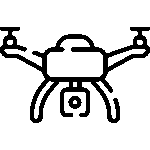 Drones
Drones Gimbals
Gimbals Microphone
Microphone DRLR & Mirrorless
DRLR & Mirrorless Tripods
Tripods
 All In One
All In One Desktop Computers
Desktop Computers Mac Mini
Mac Mini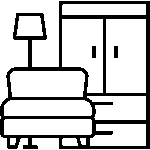

 Projectors
Projectors

 Tablets
Tablets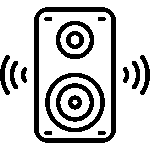 Speakers
Speakers
